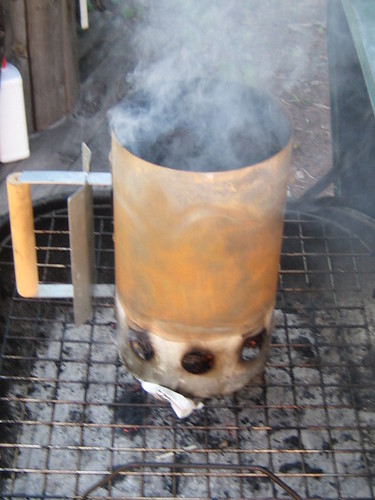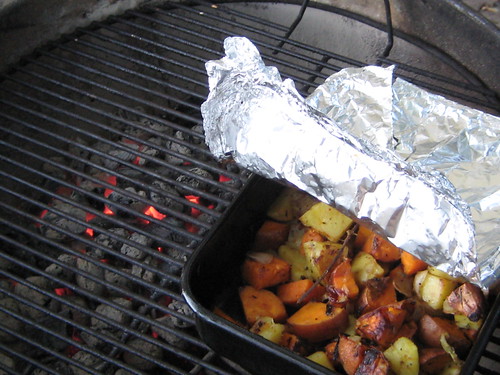recipe: eggplant parmigiana on the grill
The haphazard success I achieved making roasted potatoes on the grill has inspired further experimentation with using a charcoal grill as an oven. As mentioned last time, baking/roasting food on the grill, in place of your indoor oven, keeps your house cool during the hot months. It also maximizes the amount of heat you actually use from your coals, since the most common use of charcoal is high heat, short term, flash-grilling for steaks, sausages, vegetables, etc. It's surprising how long a briquette will generate heat, so put that energy to good use by slow-cooking something before you flip the  burgers.
burgers.
How it happened: yesterday I realized there was a bag of slender, pale-purple eggplants sitting in my fridge, just waiting for a simple summer preparation. My brain immediately leaped to a seductive recipe for eggplant parmigiana in one of my favorite Italian cookbooks, for which the ingredients and technique just begged for smoky hot coals. Moreover, it's not comfortable or convenient to set up a chaise longue in the kitchen, so do yourself a favor and bake this on the grill while soaking up some shade.
Ingredients:
- 2 pounds eggplant (any variety), sliced into 1" disks
- 2 15 oz cans of diced tomatoes (good ones)
- 1 bunch basil leaves
- 4 cloves garlic (slightly crushed)
- .5 lbs fresh mozzarella cheese, cut into 1/2 inch cubes
- 1/4 cup grated parmesan cheese (don't even think about the green can from Kraft. if you live in the midwest, try Sartori Parmesan from WI - it's a local alternative to the real stuff from Italy)
- olive oil
- salt
- pepper
- Start a full chimney-load of charcoal.
- While coals heat up, coat the bottom of a deep-sided baking pan (brownie pan works well) with about 2 tbsp olive oil.
- Layer eggplant slices in an orderly fashion across the bottom of the pan - you may need to or three layers to fit all the eggplant. Grind some pepper over the top and drizzle with some more oil. Stuff the garlic cloves randomly into the eggplant layers.
- When coals are hot, deposit them on one side of the grill, making a tidy-looking pile (you may need to use some tongs).
- Set the baking pan on the grill grate directly over the coals. Cover grill, open vents, and let it cook for about 12-15 minutes.
- Remove grill cover and check the color of the eggplant, it should take on a light brown color at this point (if it still looks raw you'll want to leave it on for another 5-10 minutes). You should also use a tongs to check one of the bottom slices, to make sure they're not burning.
- Once the eggplant has browned slightly, remove it from the grill and add another 10-15 charcoal briquettes to the existing pile (this is important, as it keeps the grill hot).
- Layer the basil leaves on top of the eggplant. Then pour the diced tomatoes over the basil. Then add the mozzarella and parmesan.
- Put the pan back on the grill, but on the cool side. Cover grill and roast for 25-30 minutes, or until cheese is melted and bubbly. Make sure you don't peek at the dish too early, because each time you lift the cover you release the heat from your grill.
- While patiently waiting for cheese to melt, prepare the remaining elements of your meal, which you can cook over the hot side of the grill once the eggplant is done - you should have plenty of heat left in the coals.
- Congratulate yourself on yet another rustic, yet elegant, grilling victory.


